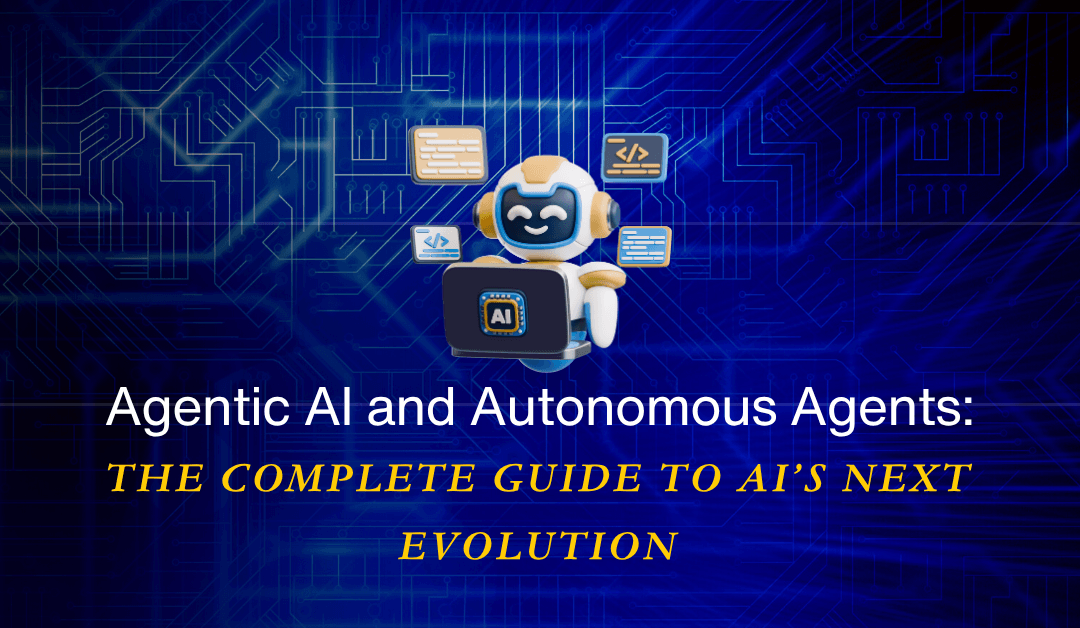From Prompts to Proactive Partners: Understanding Agentic AI and Autonomous Agents
We’ve all gotten used to the current generation of AI. We give it a prompt, and it gives us a response. It’s a powerful tool, but it’s fundamentally reactive. It waits for our command. Now, a new paradigm is emerging, one that shifts AI from a passive tool to a proactive partner: Agentic AI and Autonomous Agents.
This isn’t just a minor upgrade; it’s a fundamental change in how we will interact with technology. But what does “agentic” even mean? And how autonomous are these new systems? This guide will break down what you need to know about the next major leap in artificial intelligence.
What Makes AI “Agentic”?
At its core, “agentic” means having agency. It’s the ability to act independently and make choices to achieve a specific goal.
Think of it this way:
- Reactive AI (like ChatGPT): You ask it to “write an email to my boss asking for Friday off.” You have to review the draft, copy it, open your email, paste it, and hit send. You are the agent managing the process.
- Agentic AI: You say, “Get me this Friday off.” The AI agent plans a course of action. It checks your calendar for conflicts, accesses your email, drafts a polite request (in your style), sends it, and even sets a reminder to follow up if your boss doesn’t reply.
This simple example highlights the key difference: Agentic AI and Autonomous Agents are given goals, not just prompts.
The Core Components of an Autonomous Agent
So, what’s under the hood? How can an AI system plan, act, and adapt on its own? While the specifics vary, most autonomous agents share a few key components:
- Planning & Reasoning: When given a complex goal (e.g., “Research the top 5 competitors for my new coffee shop and summarize their pricing”), the agent breaks it down into a sequence of smaller, manageable tasks.
- Tool Use: This is crucial. An agent isn’t limited to its own knowledge. It can be given “tools,” which are other programs or APIs. It can browse the internet, access files, run code, or connect to other software to gather new information and execute tasks in the real world.
- Memory: To complete a multi-step plan, an agent needs memory. This includes short-term memory (like a scratchpad for the current task) and long-term memory (learning from past successes and failures to improve future performance).
- Self-Correction: What happens when a task fails? A key feature of Agentic AI and Autonomous Agents is their ability to recognize an error, analyze why it happened, and create a new plan to get back on track—all without human intervention.
Real-World Impact: Where Will We See AI Agents?
This technology is moving from theoretical research to practical application at a stunning pace. The impact will be felt across nearly every industry.
- The Ultimate Personal Assistant: Imagine an AI agent that doesn’t just set reminders but actively manages your life. It could book your entire vacation (flights, hotels, and restaurant reservations) based on your budget and preferences, optimize your daily schedule, and proactively handle your email inbox.
- Automated Business Processes: Companies are already building Agentic AI and Autonomous Agents to act as “virtual employees.” These agents can run marketing campaigns, perform complex data analysis, manage supply chains, or handle sophisticated customer support inquiries from start to finish.
- Software and Science: In technology and research, agents can write, debug, and test their own code, dramatically accelerating development. In science, they can design and run experiments, sift through massive datasets to find new drug candidates, or model complex climate scenarios.
The Big Challenge: Trust and Control
Of course, the idea of a fully autonomous AI system making its own decisions brings up valid concerns. The power that makes Agentic AI and Autonomous Agents so revolutionary—their autonomy—is also their greatest risk.
Ensuring these agents are safe, reliable, and aligned with human values is the single most important challenge facing developers today. We need robust “guardrails” to prevent them from taking unintended or harmful actions. The conversation is no longer just about “Is the AI’s answer correct?” but “Is the AI’s action safe and beneficial?”
The Agentic Era is Just Beginning
We are standing at the very beginning of the agentic era. The shift from simply asking AI for information to delegating tasks to it will be as transformative as the invention of the web browser or the smartphone.
These systems will become our collaborators, our assistants, and our specialists, capable of handling complex, real-world problems. Understanding the fundamentals of Agentic AI and Autonomous Agents isn’t just for tech-savvy; it’s essential for anyone who wants to understand the future of work, business, and daily life.

